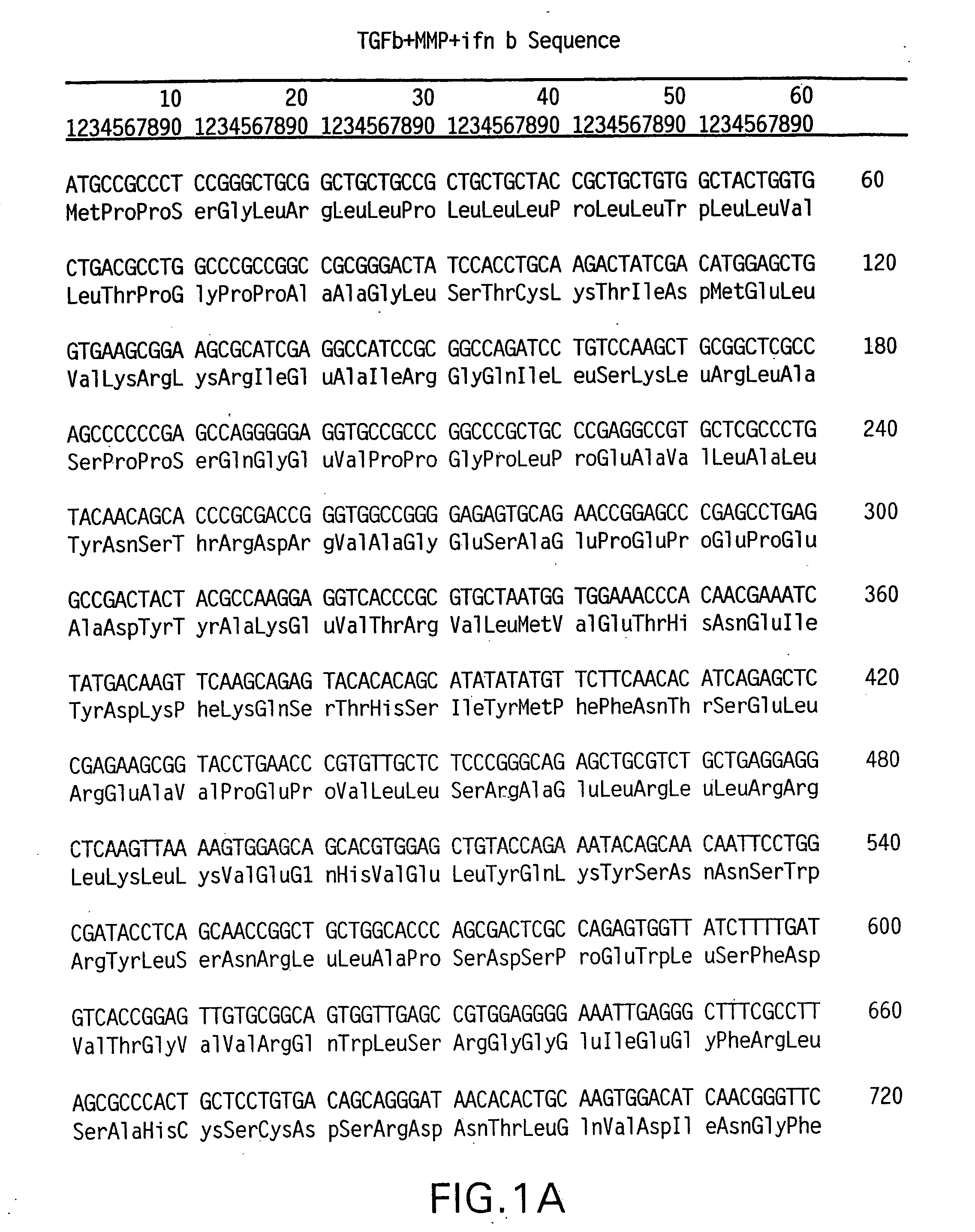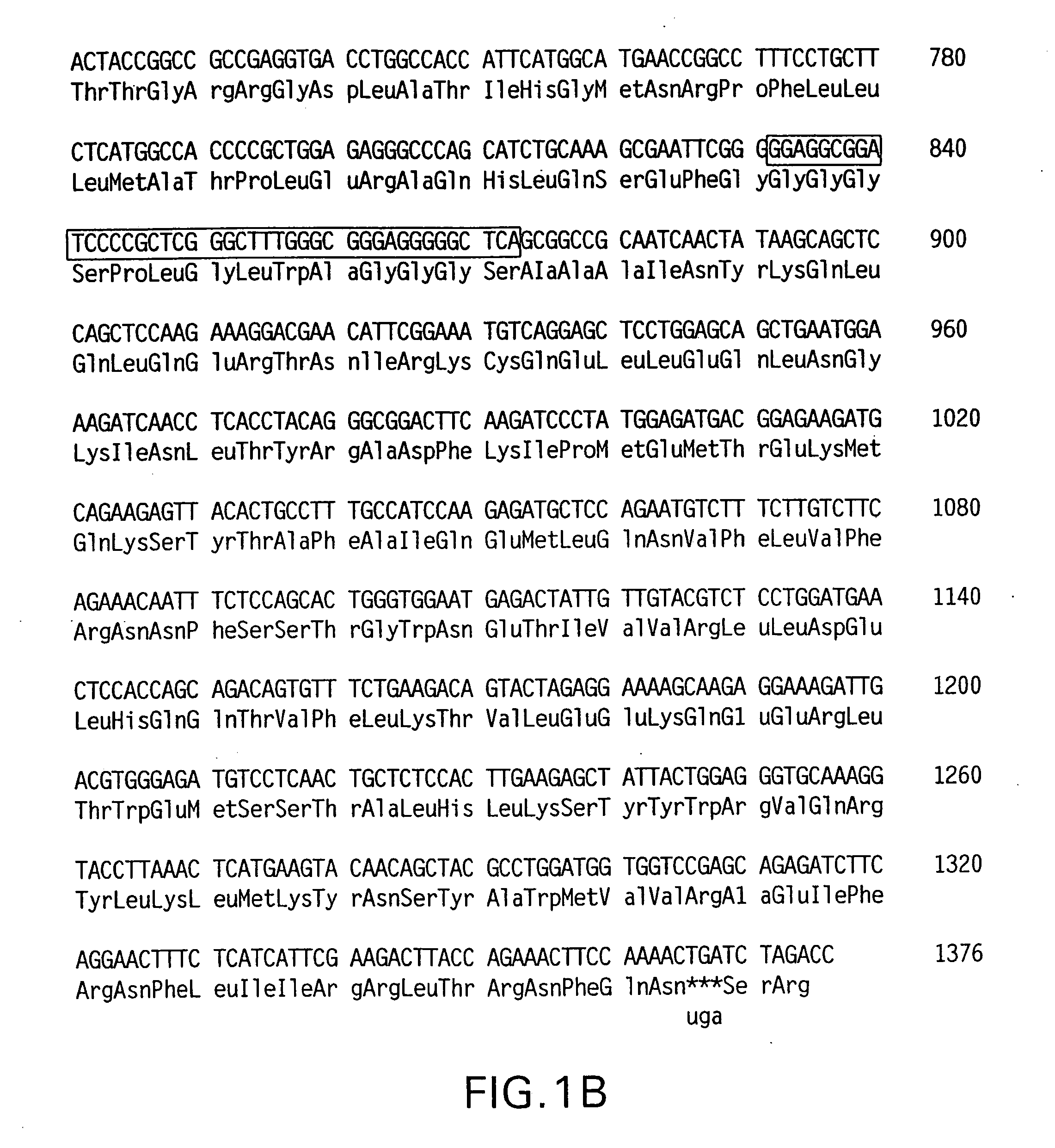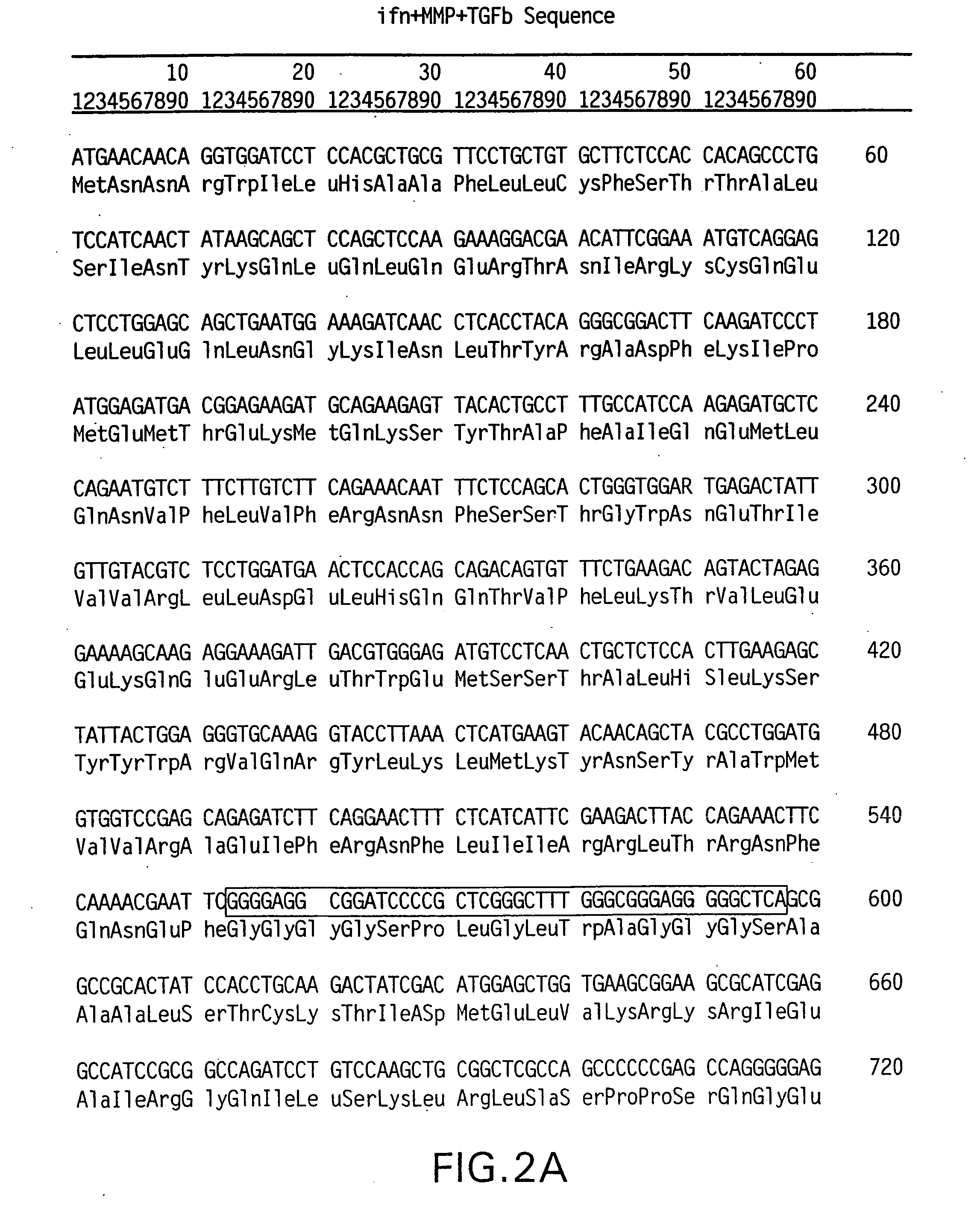Latent fusion protein
a technology of fusion protein and latent protein, applied in the field of dna constructs, can solve the problems of limiting the use and efficacy of latent proteins, unsatisfactory systemic effects,
- Summary
- Abstract
- Description
- Claims
- Application Information
AI Technical Summary
Benefits of technology
Problems solved by technology
Method used
Image
Examples
example 1
Construction of LAP-mIFNβ and mIFNβ-LAP
Methods
Cloning of GS-MMP-GS Linker into EcoR1-Not1 Sites of pcDNA3
[0108] A vector was constructed by inserting the GS-MMP-GS linker into EcoR1-Not1 cleaved pcDNA3. pcDNA3 is an expression vector (from Invitrogen) which comprises the human cytomegalovirus immediate early promoter and enhancer, together with RNA processing signals allowing transcription.
[0109] Double stranded deoxyoligonucleotide coding for the sequence GLY GLY GLY GLY SER PRO LEU GLY LEU TRP ALA GLY GLY GLY SER (SEQ ID NO: 1), was designed as follows:
Sense oligo:5′ AATTCGGGGGAGGCGGATCCCCGCTCGGGCTTTG(SEQ ID NO:2)GGCGGGAGGGGGCTCAGC 3′Antisense oligo:5′ GGCCGCTGAGCCCCCTCCCGCCCAAAGCCCGAGC(SEQ ID NO:3)GGGGATCCGCCT CCCCCG 3′
[0110] Synthetic deoxyoligonucleotides were purchased from Life Technologies Ltd. (Paisley, UK). Annealed deoxyoligonucleotides were cloned into EcoR1-Not1 cleaved pcDNA3 (Invitrogen, Groningen, The Netherlands). The recombinant clone lost its EcoRV site a...
example 2
Cell Transfection Studies
Methods
Transfection into DHFR-Deficient Chinese Hamster Ovary (CHO) Cells
[0128] Dihydrofolate reductase (DHFR)-deficient CHO cells were maintained in HAM-F12 medium (Life Technologies Ltd., Paisley, UK) with 10% fetal bovine serum (FBS) (Life Technologies Ltd.), penicillin / streptomycin and glutamine.
[0129] pcDNA3 plasmids (20 μg) expressing LAP-mIFNβ or mIFNβ-LAP were each linearized with PvuI and ligated separately with PvuI cut pSV2DHFR (1 μg) (Chemajovsky et al., DNA, 3, 297-308 (1984)). After phenol extraction, the plasmids were ligated in 300 μl with T4 DNA ligase at 16° C. for 3 days. The DNA was precipitated in 0.4 M NH4 acetate and resuspended in water to be added as 1 ml calcium phosphate co-precipitate on 0.5×106 CHO cells on 9 cm plates seeded 24 hrs earlier. 4 hrs later, the cells were treated with 10% glycerol in HAM-F12 without FBS, washed in FBS-free media and left to recover for 48 hrs. Transfected cells were trypsinized and split into ...
example 3
[0162] In order to assess whether the latency detected with LAP-mIFNβ required the formation of a putative closed shell structure bounded by the dimeric disulphide linked LAP, a fusion protein was constructed using the porcine LAP that was mutated in Cys 223 and 225 to Ser.
Methods
Preparation of Construct
[0163] Porcine LAP was cloned by PCR as set out in Example 1. The primers used were as set out in Example (cloning of porcine LAP). The cloned porcine LAP was mutated in Cys 223 and 225 to Ser (Sanderson et al., Proc. Natl. Acad. Science, 92, 2572-2576 (1995)).
Transient Transfection into Monkey COS-7 Cells
[0164] 20 μg plasmid DNA, PorcLAP-mIFNβ and mIFNβ-LAP & LAP-mIFNβ controls, were transfected by the calcium phosphate co-precipitation method in duplicates to 0.5×106 COS-7 cells seeded in 9 cm plates as described above. The DNA co-precipitate was left on the cells overnight instead of 4 hrs. COS-7 cells were grown in DMEM with antibiotics and 10% FBS. 48 hrs after glycerol ...
PUM
| Property | Measurement | Unit |
|---|---|---|
| molecular weight | aaaaa | aaaaa |
| molecular weight | aaaaa | aaaaa |
| pharmaceutical composition | aaaaa | aaaaa |
Abstract
Description
Claims
Application Information
 Login to View More
Login to View More - R&D
- Intellectual Property
- Life Sciences
- Materials
- Tech Scout
- Unparalleled Data Quality
- Higher Quality Content
- 60% Fewer Hallucinations
Browse by: Latest US Patents, China's latest patents, Technical Efficacy Thesaurus, Application Domain, Technology Topic, Popular Technical Reports.
© 2025 PatSnap. All rights reserved.Legal|Privacy policy|Modern Slavery Act Transparency Statement|Sitemap|About US| Contact US: help@patsnap.com



